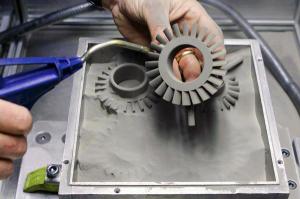3D printing stocks have taken a shellacking lately, and ExOne, manufacturer of industrial 3D printers ExOne like the Innovent and M-Flex, hit $16.09, down 2.37%. Reflecting this volatility, ExOne, with a market cap of $232.4 million, had a one year low of $13.40 and a one year high of $48.80. Investors that are in the market for the long term, however, know that progress in the industry is still going strong. Demonstrating this, yesterday, ExOne, announced the addition of 6 new materials to their metals portfolio: Cobalt-Chrome, Inconel Alloy 718, Iron-Chrome-Aluminum, 17-4 Stainless Steel, 316 Stainless Steel, and Tungsten Carbide.

Let’s learn a bit about these new materials, shall we?
- Cobalt-Chrome (Co-Cr): Cobalt-Chrome alloy has fantastic resistance properties, high melting points, and is very durable at high temperatures. Fields where high wear-resistance is needed include aerospace, cutlery, bearings and blades, and recently has received more attention for medical applications.
- Inconel Alloy 718: This is generally used for components in aerospace, chemical, and energy markets. For example, it is used to build components like gas turbine blades, filtration and separation units, and in heat exchanger and molding processes. The alloy is is preferable for its oxidation and corrosion-resistant qualities, which allow it to function well in extreme conditions.
- Iron-Chrome-Aluminum (FeCrAl): Iron-Chrome-Aluminum alloys are used to build electrical furnaces, electrical ovens, home appliances, electrical heaters, and infrared settings. They have high heat and corrosion resistance, even more so than the alloys I’ve mentioned so far.
- 17-4 Stainless Steel and 316 Stainless Steel: In the automotive, medical, and general industry markets, these alloys are used to produce surgical tools, metallic filters, pumps, impellers, and structural automotive parts. These grades are known for being cost-effective, as well as having excellent mechanical and corrosion resistance properties.
- Tungsten Carbide (WC): With a melting point of 2770°C, Tungsten Carbide is used mainly in the manufacturing of high wear-resistant abrasives, carbide cutting tools (knives, drills and circular saws), and milling and turning tools used by metalworkers, woodworkers, miners, as well as the petroleum and construction industries.
Though the recent market volatility has had some questioning the future, it’s important to keep things in perspective. The hype cycle is ending, and steady growth should follow. From 2011 to now, 3D printing companies have raised nearly $4 billion in public offerings. If you compare that to the 23 years before that, the difference is staggering. There was about $300 million raised from 1987 to 2010. Probably the most significant point to keep in mind is the correlation between the relatively new interest by public investors, and the number of companies formed and acquired. Obviously not all of them will survive.



